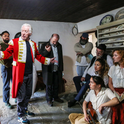FILM
An Education On general release from 30th October So rarely does a British film turn up with all its faculties at full voltage, feeling naturally cinematic and yet completely English, that Lone Scherfig’s An Education feels like that near contradiction in terms: a mainstream coup. This perceptive portrayal of a 1960s teenage girl swot’s seduction by a smooth-talking older man has all its creative upholstery beautifully fitted and finished, and it handles its coming-of-age theme with a genuine feel for its time and suburban locale. There’s a dazzling performance from Carey Mulligan as Jenny, managing the transition from awkward schoolgirl to woman-of-the-world with invisible skill; equally adept is Peter Sarsgaard as David the elusive charmer, and there’s a return to his best form from Alfred Molina as the well-meaning dupe of a Twickenham father, initially bent on getting his girl into Oxford but then banjaxed by David’s glamour. Watch out, too, for the insights of Rosamund Pike’s deadpan blonde party girl Helen. With a deftly fizzing script from Nick Hornby, based on Lynn Barber’s memoir of her youth, and the perceptive eye for British absurdities of Danish director Scherfig, previously responsible for the more lugubrious Wilbur Wants to Kill Himself, this is a treat of a movie and a demonstration of what straightforward British cinema could and should be like. It knocks just about every other set-in-the-1960s British film I can think of into a pork pie hat.
Nick James is editor of Sight & Sound
GALLERY
David Hockney Nottingham Contemporary, 14th November-24th January 2010, www.nottinghamcontemporary.org
You may think this is not the moment for a flashy regional contemporary art gallery to be opening—but the delayed Nottingham Centre for Contemporary Art has a great deal going for it. Designed by Caruso St John on a difficult but central site, near the historic Lace Market, it will be the fourth largest contemporary art museum in England without, like the Baltic and indeed the Whitechapel, a permanent collection. Its remit is not just to educate and entertain locally but to create exhibitions of international significance.
More than its own clever architecture and high ambitions, Nottingham Contemporary has landed as director the hugely respected curator, critic and writer, Alex Farquharson. Farquharson first drew attention in the 1990s with adventurous exhibitions at Spacex, Exeter, and the Centre for Visual Arts in Cardiff (where he staged an exhibition with Turner prize winner Jeremy Deller based on the Manic Street Preachers). As lecturer at the RCA and freelance curator abroad he has further honed his line in intelligent, popular, creative exhibition-making. In 2006, he co-curated the British Art Show 6, which came to Nottingham, and for Tate St Ives he brought art and pop culture together for the Brian Wilson (Beach Boys)-inspired “If Everybody Had An Ocean.” Nicholas Serota is a big supporter, and the centre is one of the 11 favoured “Tate Connects” organisations, sharing expertise across galleries. Launching this inside track in Nottingham is David Hockney 1960-1968: A Marriage of Styles, the first time this period has been explored since the 1970s. So ubiquitous have the early Californian images become that we have stopped looking. Farquharson wants to reacquaint us with “the real strangeness” of Hockney’s work.
Emma Crichton-Miller is an arts writer MUSIC
Martha Wainwright Sings Piaf Barbican, 11th November, Tel: 0845 120 7550, www.barbican.org.uk Tributes to easy listening icons are a risky business. At best they can sound nostalgic and second rate, at worst like a cheap shot at selling sack-loads of contemporary CDs on the back of someone else’s pony. In her new Edith Piaf show, however, singer songwriter Martha Wainwright has dodged such predicaments, interpreting France’s most cherished chanteuse with charm, intelligence and wit. Forgoing karaoke classics like “Non, Je Ne Regrette Rien” for less familiar songs—“Une Enfant” laments the demise of a foolish 16-year-old girl who falls for a blackguardly bohème—Wainwright has transcended French nationalism and connected Piaf’s emotional and tragic heart to her own lovelorn sensibilities of dejection, irony and conceit. And as a French speaker herself (she grew up in Canada with brother Rufus) she delivers the songs easily, backed by a band sympathetic to the eccentricities of Piaf’s arrangements.
Edith Piaf has enjoyed several revivals in recent years, notably in the 2007 Oscar-winning film La Vie En Rose and last year’s stage show, Piaf. But Wainwright’s interpretations hope to lift her out of Parisian cliché and into a contemporary context in which a new generation of fans awaits. A live recording and DVD is due out this autumn.
Nick Crowe is a music writer PAINTING
The Conversation Piece The Queen’s Gallery, Buckingham Palace, 30th October-14th February 2010, Tel: 020 7766 7301, www.royalcollection.org.uk
The conversation piece—a genre of painting, popular in the 18th century, which depicts groups of friends or family engaged in activities, both everyday or extraordinary—occupies an unfairly low position in the traditional hierarchy of painting. No other images from the period show us in such detail and richness how people, albeit mostly the upper classes, lived. In this exhibition, which traces the roots of the genre back to 17th-century Holland, there are tea parties, private concerts, hunting trips, luxury holidays and royal walks in the park. The power and pleasure of these images derive from this tantalising contradiction of the staged and the documentary: they are the closest painting gets to showing reality while being, at the same time, highly calculated idealisations. That makes them a real forerunner of the photographic image. In their depiction of monied, upper-class entertainment, often peppered with ironic detail, these pictures are precursors to Martin Parr’s photographs of middle-class mores and the staged photography of Canadian Jeff Wall.
Ben Lewis is a writer and broadcaster DANCE
Mark Morris Dance Group On tour including Sadler’s Wells, 27th-31st October, Tel: 0844 412 4300, www.sadlerswells.com
There’s nothing obviously noteworthy about a choreographer who is inspired by music. But after Mark Morris has worked with a score you never hear it the same way again. It is partly the depth and detail with which he translates music into movement that has earned 53-year-old Morris the reputation of being the greatest American dance-maker of his generation. His capacity to illuminate a score’s structure in fresh ways and reimagine its dynamics as dark, funny, tender human expression has resulted in musicians of the calibre of Yo Yo Ma and pianist Emanuel Ax queuing up to play for Morris and his New York-based dancers. But the musical impact of his choreography also lies in its exceptional range, as he alights on scores that have rarely, if ever, been used for dance. For his company’s five-week British tour that includes the work of Lou Harrison, Samuel Barber and Bob Wills and His Texas Playboys; and among four works new to Britain are Visitation, a dance about memory and haunting set to Beethoven’s 4th Piano concerto, and Empire Garden, a portrait of America that takes its raucously affectionate and satiric tone from its Charles Ives score. With four different programmes alternating between venues, the tour is an astonishingly rich diet for dance and music fans alike.
Judith Mackrell is the Guardian’s dance critic THEATRE
Roman Tragedies by Toneelgroep Amsterdam Barbican, 20th-22nd November, Tel: 0845 120 7550, www.barbican.org.uk
In the 11 years since Bite was born this eclectic theatre programme, formally known as Barbican International Theatre Event, has grown into Britain’s most committed importer of event theatre. No other project attracts as many innovators or so regularly tests boundaries. And few Bite shows will have got further from theatrical conventions—proscenium arch, actors on a stage, that kind of thing—than Toneelgroep Amsterdam’s epic Roman Tragedies.
Here, boundaries are not just pushed but removed. The audience has the right to roam onstage among director Ivo van Hove’s edited versions of Shakespeare’s Coriolanus, Julius Caesar and Antony and Cleopatra in which live performance merges with video transmission. Van Hove used similar techniques with the films of Italian director Michelangelo Antonioni. The result reinvents the stage.
Shakespeare is no stranger to Bite, whose six-month season doubled in 2002 to fill the hole left by the RSC’s retreat to Stratford. Theatre companies worldwide have since exported the bard to the English. There has been a Japanese Hamlet, Spanish Macbeth, Russian Lear and a Korean Romeo and Juliet. Purists may balk at Van Hove’s high-tech, interactive Shakespeare, but Bite thinks nothing is sacred.
John Nathan is a journalist and theatre critic

Prospect recommends
October 21, 2009











